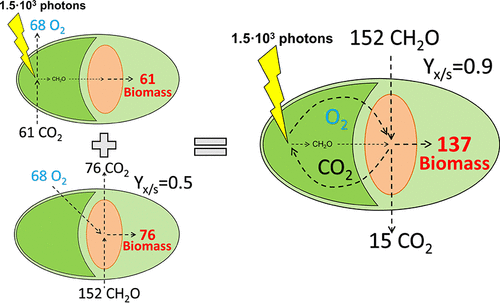当前位置:
X-MOL 学术
›
ACS Sustain. Chem. Eng.
›
论文详情
Our official English website, www.x-mol.net, welcomes your
feedback! (Note: you will need to create a separate account there.)
Doubling of Microalgae Productivity by Oxygen Balanced Mixotrophy
ACS Sustainable Chemistry & Engineering ( IF 7.1 ) Pub Date : 2020-03-25 , DOI: 10.1021/acssuschemeng.0c00990 Fabian Abiusi 1 , Rene H. Wijffels 1, 2 , Marcel Janssen 1
ACS Sustainable Chemistry & Engineering ( IF 7.1 ) Pub Date : 2020-03-25 , DOI: 10.1021/acssuschemeng.0c00990 Fabian Abiusi 1 , Rene H. Wijffels 1, 2 , Marcel Janssen 1
Affiliation

|
Microalgae productivity was doubled by designing an innovative mixotrophic cultivation strategy that does not require gas–liquid transfer of oxygen or carbon dioxide. Chlorella sorokiniana SAG 211/8K was cultivated under continuous operation in a 2 L stirred-tank photobioreactor redesigned so that respiratory oxygen consumption was controlled by tuning the acetic acid supply. In this mixotrophic setup, the reactor was first operated with aeration and no net oxygen production was measured at a fixed acetic acid supply rate. Then, the aeration was stopped and the acetic acid supply rate was automatically regulated to maintain a constant dissolved oxygen level using process control software. Respiratory oxygen consumption was balanced by phototrophic oxygen production, and the reactor was operated without any gas–liquid exchange. The carbon dioxide required for photosynthesis was completely provided by the aerobic conversion of acetic acid. Under this condition, the biomass/substrate yield was 0.94 C-molx·C-molS–1. Under chemostat conditions, both reactor productivity and algal biomass concentration were doubled in comparison to a photoautotrophic reference culture. Mixotrophic cultivation did not affect the photosystem II maximum quantum yield (Fv/Fm) and the average-dry-weight-specific optical cross section of the microalgal cells. Only light absorption by chlorophylls over carotenoids decreased by 9% in the mixotrophic culture in comparison to the photoautotrophic reference. Our results demonstrate that photoautotrophic and chemoorganotrophic metabolism operate concurrently and that the overall yield is the sum of the two metabolic modes. At the expense of supplying an organic carbon source, photobioreactor productivity can be doubled while avoiding energy intensive aeration.
中文翻译:

氧气平衡的混合营养使微藻生产率提高了一倍
通过设计创新的混合营养栽培策略,不需要氧气或二氧化碳的气液转移,微藻的生产率提高了一倍。小球藻在重新设计的2 L搅拌罐光生物反应器中连续操作培养SAG 211 / 8K,以便通过调节乙酸供应来控制呼吸耗氧量。在这种混合营养的装置中,首先在曝气条件下运行反应器,并且在固定的乙酸供应速率下未测量到净氧气的产生。然后,停止通气,并使用过程控制软件自动调节乙酸的供应速率,以保持恒定的溶解氧水平。呼吸性氧气的消耗通过光养性氧气的产生得以平衡,并且反应器的运行无需任何气液交换。光合作用所需的二氧化碳完全由乙酸的需氧转化提供。在此条件下,生物质/底物的产率为0.94 C-mol x·C-mol S –1。在恒化条件下,与光合自养参考培养相比,反应器生产率和藻类生物质浓度都翻了一番。混合营养培养不影响光系统II的最大量子产率(Fv / Fm)和微藻细胞的平均干重比光学截面。与光合自养参考相比,在水合养分培养中,仅叶绿素对类胡萝卜素的光吸收降低了9%。我们的结果表明,光合自养和化学有机营养同时进行,总产量是两种代谢方式的总和。以提供有机碳源为代价,光生物反应器的生产率可以提高一倍,同时避免了能量密集的曝气。
更新日期:2020-04-23
中文翻译:

氧气平衡的混合营养使微藻生产率提高了一倍
通过设计创新的混合营养栽培策略,不需要氧气或二氧化碳的气液转移,微藻的生产率提高了一倍。小球藻在重新设计的2 L搅拌罐光生物反应器中连续操作培养SAG 211 / 8K,以便通过调节乙酸供应来控制呼吸耗氧量。在这种混合营养的装置中,首先在曝气条件下运行反应器,并且在固定的乙酸供应速率下未测量到净氧气的产生。然后,停止通气,并使用过程控制软件自动调节乙酸的供应速率,以保持恒定的溶解氧水平。呼吸性氧气的消耗通过光养性氧气的产生得以平衡,并且反应器的运行无需任何气液交换。光合作用所需的二氧化碳完全由乙酸的需氧转化提供。在此条件下,生物质/底物的产率为0.94 C-mol x·C-mol S –1。在恒化条件下,与光合自养参考培养相比,反应器生产率和藻类生物质浓度都翻了一番。混合营养培养不影响光系统II的最大量子产率(Fv / Fm)和微藻细胞的平均干重比光学截面。与光合自养参考相比,在水合养分培养中,仅叶绿素对类胡萝卜素的光吸收降低了9%。我们的结果表明,光合自养和化学有机营养同时进行,总产量是两种代谢方式的总和。以提供有机碳源为代价,光生物反应器的生产率可以提高一倍,同时避免了能量密集的曝气。











































 京公网安备 11010802027423号
京公网安备 11010802027423号